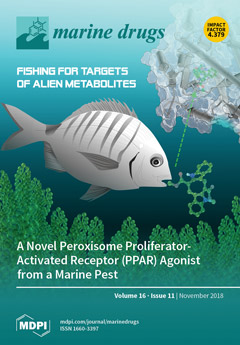Five new limonoids named thaigranatins A–E (
1–
5), containing a C
1–
O–C
29 moiety, were isolated from seeds of the Thai
Xylocarpus granatum, collected at the mangrove swamp of Trang Province, together with the known limonoid,
[...] Read more.
Five new limonoids named thaigranatins A–E (
1–
5), containing a C
1–
O–C
29 moiety, were isolated from seeds of the Thai
Xylocarpus granatum, collected at the mangrove swamp of Trang Province, together with the known limonoid, granatumin L (
6). The structures of these compounds were established by HR-ESIMS and extensive NMR spectroscopic data. The absolute configuration of
1 was unequivocally determined by single-crystal X-ray diffraction analysis, conducted with Cu Kα radiation; whereas that of
2 or
6 was established to be the same as that of
1 by the similarity of their electronic circular dichroism (ECD) spectra. In view of the marked antiviral activity of
6, its structure was modified via hydrolysis with alkaline KOH, esterification with diazomethane and various organic acids, and oximization with hydroxyamine. Finally, 18 derivatives,
viz. 7–
10,
8a–
8i,
9a–
9b, and
10a–
10c, were obtained. In vitro antiviral activities of these derivatives against human immunodeficiency virus 1 (HIV-1) and influenza A virus (IAV) were evaluated. Most notably,
8i exhibited marked inhibitory activity against HIV-1 with an IC
50 value of 15.98 ± 6.87 μM and a CC
50 value greater than 100.0 μM; whereas
10b showed significant inhibitory activity against IAV with an IC
50 value of 14.02 ± 3.54 μM and a CC
50 value greater than 100.0 μM.
Full article






